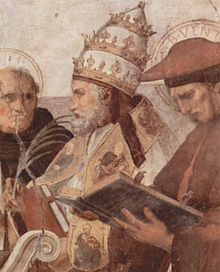Santi Sergio e Bacco al Foro Romano
Santi Sergio e Bacco al Foro Romano also called Santi Sergio e Bacco sub Capitolio , was a titular diaconia and station church in Lent in Rome, which was demolished in the 16th century . The ruins are located at the Roman Forum .
Patronage and location
The church was dedicated to the Syrian martyrs Sergios and Bakchos and was one of four churches in Rome that were listed in the Liber Pontificalis under this name. Today only Santi Sergio e Bacco stands in Callinico . Since there were two churches of these two saints near the Roman Forum, the location at the Capitol was also distinguished.
The church was built near the Arch of Septimius Severus . Mariano Armellini mentioned that it had a small bell tower , while Rodolfo Lanciani said it was separate. Lanciani also wrote that this was the only church in the Roman Forum that was not built on the foundations of another building.
Before it was destroyed, it was the station church for the third Tuesday of Lent. Successor was Santa Pudenziana .
history
Construction and expansion
The church was one of the ancient diaconia in Rome that had been established to care for the poor in Rome. In 678 Past Agatho raised her to the title of deaconry. The Syrian Pope Gregory III. (731–741) had a major expansion carried out on the oratorio , which had previously been small .
Pope Hadrian I (772–795) had the church renovated due to its poor condition. A pilgrim from Einsiedeln called the church in the same century as S. Sergii, ibi umbilicum ("The Church of St. Sergius, near the Umbilicus urbis "). In 1199 the church appears in a papal bull by Innocent III. which lists his rights and privileges. The bull lists the churches of San Salvatore de statera and San Lorenzo sub Capitolio . This Pope was cardinal deacon of this diakonia from 1190 and donated a shrine, a silver chalice and liturgical vestments . He also built the church facade with the following inscription.
PENE RVI, QVASI NVLLA FVI, SED ME RELEVAVIT LOTHARIVS [...]
PRIVS POSTQVAM RENOVAVIT. DEQVE MEO PREMIO SVMPTVS PATER VRBIS
ET ORBIS. HOC TAMEN EX PROPRIO FECIT MIHI SIC RENOVOR BIS
She also received donations from Leo III. (795-816) and Gregory IV (827-844).
demolition
In 1461 the church was listed in the Liber Anniversariorum Sancti Salvatoris ad Sancta Sanctorum and in 1492 in a catalog of the Roman churches.
Lanciani and Armellini believed that the Church was commissioned by Pope Paul III. had been torn down to enable Charles V to triumph through the Arch of Septimius Severus in 1536. Hülsen thought the story was implausible. He referred to the records of Michele Lonigo, who wrote that the church crumbled slowly and in 1562 the relics of the saints felicissimus and agapitus and the body of Vincent de Valencia in the church of Santa Maria della Consolazione transferred were. Since this happened 30 years after the triumphal procession, Hülsen said that the church had not yet been demolished at that time. In 1587, the cardinal title associated with the church was dissolved by Pope Sixtus V.
What is certain is that the church no longer existed at the end of the 16th century . At that time the benefices of eighty crowns were transferred to the Church of Sant'Adriano al Foro . Sant'Adriano al Foro has since been profaned and is only known as Curia Iulia . Evidence of the destruction of the Church of Santi Sergio e Bacco is a catalog from the pontificate of Pope Pius V (1566–1572), in which the following is written: Sto. Sergio e Baccho sotto Campid [oglio]; ruinato ("Santi Sergio and Bacco: destroyed"). The remains of the apse survived until 1812 and were demolished for the excavations of the nearby Temple of Vespasian and Titus .
Cardinal deacons
See list of cardinal deacons of Santi Sergio e Bacco
Individual evidence
- ^ Lanciani, Rodolfo Amedeo: The ruins and excavations of ancient Rome; a companion book for students and travelers . Houghton, Mifflin and Company, 1897, pp. 280-282 ( archive.org ).
- ^ Hülsen, Christian: Le chiese di Roma nel Medio Evo . Ed .: Leo S. Olschki. 1927, S. Sergii et Bacchi sub Capitolio, p. 461–462 ( uchicago.edu - Italian: Le chiese di Roma nel Medio Evo . Florence.).
- ^ Mariano Armellini: Le chiese di Roma dalle loro origini sino al secolo XVI . Tipografia Vaticana, Rome 1887, p. 609, 610 ( archive.org ).
- ^ John Baldovin: The Urban Character of Christian Worship: The Origins, Development, and Meaning of Stational Liturgy . In: Pontificium Institutum Studiorum Orientalium (ed.): Orientalia Christiana Analecta . 228, Rome, 1987.
- ^ Duchesne Louis: Le Liber pontificalis; texts, introduction and commentary . Ed .: Thorin, Ernest. Paris 1886, Gregorius III (731-741), p. 420 ( archive.org ).
- ^ Colum Hourihane: The Grove Encyclopedia of Medieval Art and Architecture . tape 2 . Oxford University Press, 2012, Innocent III, pp. 377 ( google.it ).
- ↑ Online text Liber Anniversariorum see here .
Coordinates: 41 ° 53 '34 " N , 12 ° 29' 4.8" E

